MULTICOLOURED CACTI
Dmitry Semenov
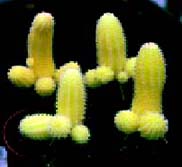 |
| Fig. 1: Achlorophyllous chamaecereus |
Who of us wouldn't be surprised having seen a coloured cactus for the first time – is it a flower or is it a berry? Something unimaginable: a yellow, orange, rosy, red or purple miniature on a stick… Nevertheless it is a cactus stem though not entirely normal – there are no such plants in the Nature. Coloured cacti are the result of mutations when the plants do not develop chloroplasts – that is, cell organelles containing chlorophyll. Thanks to chlorophyll the basic colour of cacti stems is green as in the majority of other plants. When chlorophyll lacks, the colour of the stem is defined by other pigments – red or yellow.
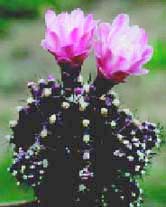 |
| Fig. 2: Coloured gymnocalycium with a black stem |
Chlorophyll does not only make cacti green, it is vitally important for their normal metabolism, being responsible for the photosynthesis process. Without photosynthesis the plants can't exist independently, that's why there are no coloured (achlorophyllous) cacti in the wild. Even in culture they can live only being grafted – always "on sticks". Thanks to a stock a coloured cactus gets hold of the necessary nourishing substances it can't synthesize itself.
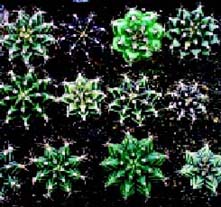 |
| Fig. 3: Green gymnocalyciums from which coloured forms sprung |
Achlorophyllous mutants appear regularly among seedlings of many cacti species, but lacking chlorophyll they can't grow and quickly die. If you graft them onto another cacti they will be able to develop and with time turn into the coloured copy of their green fellow plants. It was in Japan where they guessed to graft tiny seedlings, from there the wonderful coloured cacti spread all over the world. That's why the original names of these cacti are Japanese.
The first red gimnocalyciums to appear in Moscow were called "the red caps" and made a real commotion there. They were incredibly costly and ranked very high at the exhibitions.
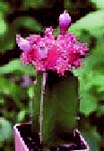 |
| Fig. 4: These decorative gymnocalyciums flower and bear fruits as well as normal ones |
Later it turned out that picking achlorophyllous mutants out from the seedlings it's possible to get coloured forms of various cacti – Echinopsis, Mammillaria, Rebutia, Ariocarpus, Astrophytum and others. But time put everything in its place. It became clear that mysterious beauty of cacti is chiefly determined by their slow growth; only mature and correctly cultivated plants are truly beautiful. The coloured forms are defective originally and being on the graft they can't grow according to their natural genetic program. As a result we may see those parts of a grafted plant that in a normal cactus move into soil with time. Thus the natural squat form turns into an ungainly stretching. On the whole there are widely spread in culture only the coloured forms of those cacti which grow quickly, mature early and are easily propagated vegetatively because it's too much bother to look for mutants in the crops. They are the numerous coloured forms of Gymnocalycium mihanovichii, Gymnocalycium stenopleurum and also the yellow-stemmed Chamaecereus (now Chamaecereus is included into genus Echinopsis and its correct name is Echinopsis chamaecereus).
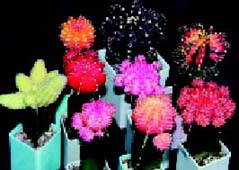 |
| Fig. 5: These cacti may be used as live decorations |
Now you can buy coloured cacti in almost any flower shop. They are relatively cheap and amazingly beautiful. In contrast to other cacti they are undemanding and that's easily explained because they live at the stock's expense and don't use light for their own photosynthesis. They themselves need neither sun nor special treatment nor special temperature range – all this is of no importance provided the stock is alive. That's why the coloured graftings may be placed anywhere for rather a long time, for example as living decorations. It would be a good idea to use them in various decorative or humorous compositions – each of them will be bright and inimitable. To make a composition the plants may be used together with the pots or they may be repotted into the most unusual containers where you can put some soil and arrange attractive stones at the top. Achlorophyllous forms may also be recommended to those people who believe in the beneficial counteraction of cacti to harmful computer irradiation – the coloured plants are small, smart, not spiny at all and don't stretch without sunlight.
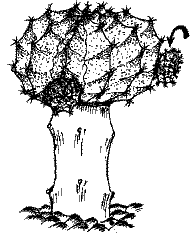 |
| Fig. 6: Grafting of a cactus |
The coloured cacti are easily propagated by grafting, better than most of other cacti. You may use as stocks the most tenacious cacti, e.g. the rooted off-shoots of an Echinopsis or another not very valuable and vigorously growing cactus. As scions the off-shoots of coloured gymnocalyciums or short stems of yellow Chamaecereus are usually used. The off-shoots are removed from the mother plant by turning them around their axis. After their removal the off-shoots are evenly cut at the base by a sharp disinfected blade. The cut is superposed with the cut on the stock and the graft is fixed by a soft rubber band.
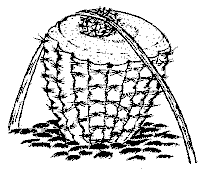 |
| Fig. 7: Grafting of a cactus |
The graft is covered by plastic or a glass hood for some time, the fresh air shouldn't be blocked completely at that. The stock is watered and the grafted plant is kept at the temperature a bit higher than the room temperature. It's a pity but these grafts are not very long-living – two years may be considered a good stretch of time. Though by careful cultivation a coloured cactus lives longer than usual, it may bloom and even bear fruits. These cacti suffer from sunburns that's why you shouldn't place them in the bright sun at once.





